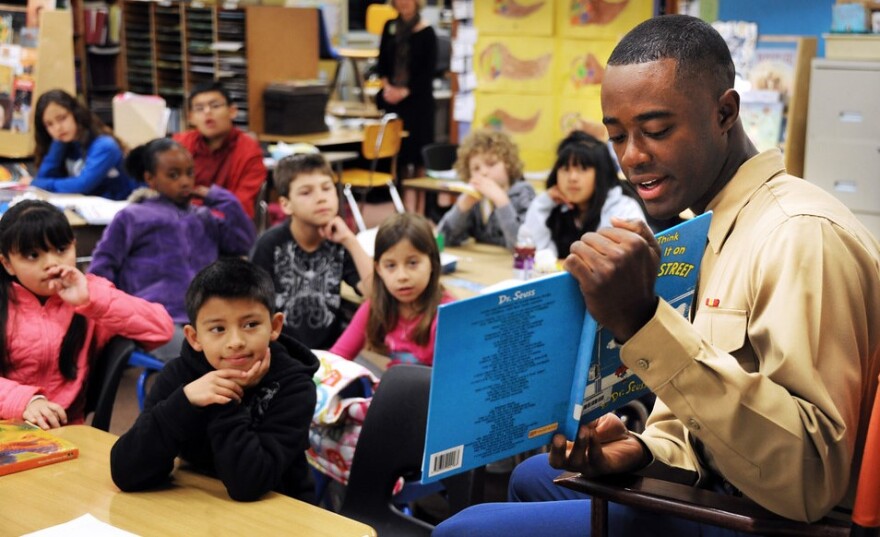Sometimes, it can be intimidating to read to children. WCMU's Sue Ann Martin gives some tips for how to do this, and keep your children engaged.
- CHOOSE A GOOD STORY (Selection): A well selected story will have a lot of action, vivid characters, a definite plot sequence and many vocal interests including onomatopoeia, alliteration, animal mimicry, machine sounds, street cries, and rhyme. Story selection should match the age-interest level of the child.
- MAKE IT REAL (Imagery): Experience the story’s imagery first hand. Really touch, smell, see, taste and hear what you are describing. If the teller is genuinely involved, the listeners will be involved. Taste that porridge, see that pumpkin turn into a carriage, and hear that giant coming after Jack!
- BUILD THE SUSPENSE (Tempo and Volume): Pace the action orally through the use of the word stretch. Elongate vowels in each word as you s-l-o-w-l-y describe t-i-p- t-o-e-i-n-g a-c-r-o-s-s t-h-e b-r-i-d-g-e so as not to wake the troll. Hushed whispers can also enrich the anticipation and the suspense.
Goldilocks and the Three Bears
Dr. Sue Ann Martin demonstrates how to read for children, in this rendition of "Goldilocks and the Three Bears."
- BRING THE CHARACTERS TO LIFE (Vocal Quality): Speak the dialogue with the attitude and voice of each character. Let the listener hear the wolf huffing and puffing outside the door. Pay attention to the BIGNESS, smallness, smoothness, gruffness of each character’s vocal quality. Young, naive, and sweet characters, like Little Red Riding Hood, often speak with a small, oral quality. Powerful, courageous characters like The Great Oz, often speak with a big, orotund vocal quality. Tough, street-wise and menacing characters, like Captain Hook, often use a raspy, guttural quality. Eerie, other worldly characters, like the Ghost of Christmas Past, often speak with a chesty, pectoral quality. Comic and whining characters, like Eeyore, often speak with a flat, nasal quality. Ill or seductive characters, like the Golum, often have a breathy, aspirate vocal quality half phonated and half whispered, “ my precious.”
- EMPHASIZE THE HUMOR (Planting): Use the vocal pause, a space of silence, just prior to the words that hold the joke or humor. This will plant the humor by separating it from the rest of the story. Comedians use this technique so that the humor does not get lost. Using the vocal pause prior to the punch line is the most common and most exaggerated technique. Using the pause just after the punch line is a more subtle, satiric technique. The vocal pause can also draw attention to key words, phrases and actions that hold the story together.
- KEEP IT INTERESTING (Vocal Animation): Use a variety of pitches, tempos, and volumes. Exaggerate the tone color of each word by making your voice do what the action of the word suggests. Put the action of the word into your voice. For instance, the word “surge” will grow as it is spoken, the word “lift” will rise in inflection and the word “collapse” will fall in inflection. “Quick” needs to be short and abrupt. “Soft” needs to be spoken in a smooth, quiet manner. Vocally meet the wild things and “let the wild rumpus start!”
- LET THE BODY TALK (Physical Animation): Allow your body tone, gestures, and facial expression to respond to the story’s circumstance, imagery, suspense, and humor. Please do not plan gestures because the timing will always be off and not legitimate. Allow gestures to arise spontaneously from your genuine involvement with the dramatic action of the narration.
- MAINTAIN A DIRECT LINE OF COMMUNICATION (Eye Contact): Eye contact is necessary to establish a human link between the teller and the child. A circular response, made possible by eye contact, bonds everyone to the act of story from transmitter to receiver and back again. Beware of anything that obstructs eye contact such as hair, sunglasses, baseball caps, and a possible habit of failing to look directly at the child. And, oh yes, have fun!!



